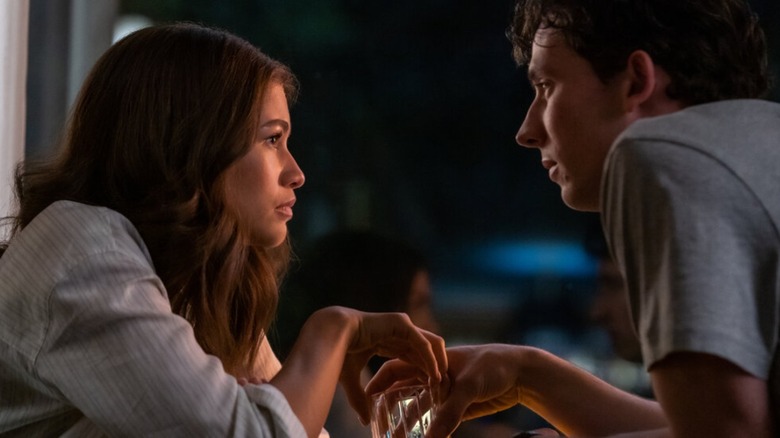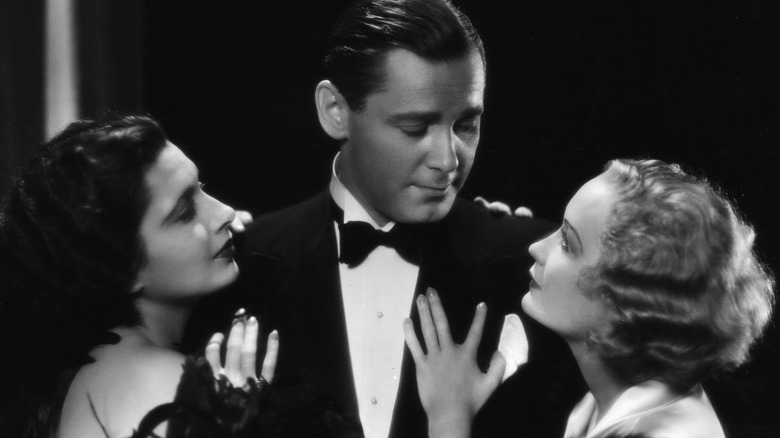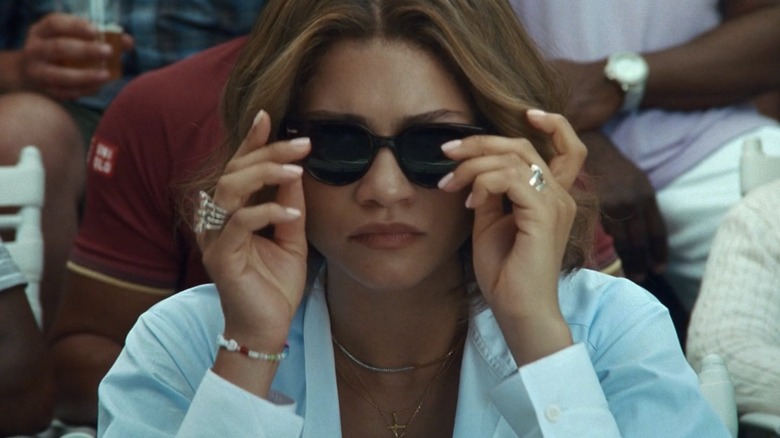Luca Guadagnino's Challengers Takes Cues From The Classic Films Of These Directors
Much has been made about the smoky sexiness of Luca Guadagnino's "Challengers," notably the brief threesome scene near the beginning of the movie. While the scene is plenty sexy, it constitutes the bulk of the on-screen physicality of "Challengers," and it is, perhaps disappointingly, relegated to about 90 seconds of tongue kissing; Guadagnino's film is not the bisexual throuple film the ad campaign would have you believe it is.
Instead, it's a soapy, recognizably classical love triangle about three bitter souls who were never able to get over that fateful make-out session. The three players involved were promising tennis champions in high school. There's Tashi (Zendaya), the hotshot celebrity that is already being courted by marketers. There's Patrick (Josh O'Connor), the rough-hewn, stubble-encrusted stud. And there's Art (Mike Faist), the talented jokester whose magic shell quickly hardens into a crunchy layer of jealousy. "Challengers" follows them, via flashbacks, through their foolish 20s as they run into career blockages, experience injuries, and date each other in two separate iterations. It's all very "One Life to Live."
The romantic action culminates in a tennis match between Art and Patrick — the former married to Tashi, the latter barely scraping by — where a decade of seething resentment can play out on the court. How much do these two still hate each other, and which one does Tashi truly love?
The sexy opening scenes might have one assuming that Guadagnino took his creative cues from the artier 1970s sexploitation directors — see: Radley Metzger — but in a recent interview with the New York Times, the filmmaker reveals that his inspiration sources came from earlier decades of Hollywood history. Notably, he cited Ernst Lubitsch and Preston Sturges, two of the inventors of the modern romantic comedy.
Lubitsch and Sturges
O'Connor was also present for the interview, and he was shocked to hear from audience members that his character, Patrick, was hated. O'Connor felt that Patrick is not a villain, nor are Art and Tashi. They are all human characters with understandable desires and interests ... and they are all lovable. Guadagnino noted how that was the point, saying:
"The approach of the movie is very old Hollywood, like Preston Sturges, Lubitsch. The leading characters were fierce, feisty, complex, yet fun and seductive."
Those unfamiliar with Preston Sturges have a glorious road of discovery ahead of them. Sturges was a notable Hollywood screenwriter throughout the 1930s and became a powerhouse director in the '40s and early '50s, helming classic screwball comedies like "The Lady Eve," "Sullivan's Travels," and "The Palm Beach Story." He was known for elevating screwball comedies into something mature and adult, writing more natural dialogue and wry, humorous characters; he didn't rely on slapstick or stylized farce. His films rotated wildly through moods, sometimes being funny before tilting directly into tragedy, then unexpectedly ending with joy. One can see that "Challengers" borrows from the Sturges' adult characters and tone roulette.
Even if you think you're not familiar with Ernst Lubitsch, you probably are. His romantic farces of the 1930s and 1940s, including the Jimmy Stewart classic "The Shop Around the Corner," laid the foundation for comedic film directors for generations; Billy Wilder famously had a sign reading "What would Lubitsch do?" on the wall in his office. He was known for what came to be known as "The Lubitsch Touch," which biographer Scott Eyman described as creating "a world of delicate sangfroid, where a breach of sexual or social propriety and the appropriate response are ritualized, but in unexpected ways."
In Lubitsch's comedies, sex may not be on the screen, but it's in every frame.
Zendaya's take
In "Challengers," Guadagnino includes a lot of short tennis shorts, a sweaty sauna, and steamy car windows, so his sex is more forthright than one might see in a Lubitsch film. One can see, however, his attempts to recreate the Lubitsch touch. Of course, most modern filmmakers, whether or not they realize it, are drawing inspiration from Lubitsch and Sturges. To this day, the techniques, characters, and tones they helped to pioneer drift like clouds above every Hollywood production. Guadagnino was just more explicit about it.
Zendaya, who was challenged in more ways than one for this film, was also present for the New York Times interview, and she seemed to take a more personal approach to her character. Zendaya knew that "Challengers" should probably be more sophisticated than a mere erotic potboiler, and that would require more subtlety. A good person, she realizes, can and will do bad things in their lives. The actress explained:
"When we talked [about the script], I was like, 'I could just make her a straight up B-word.' That was always our line to walk, never making her feel completely cold. How do we find nuance, and how do we make her feel sensitive and fragile? I think she's falling apart and you're watching a woman scramble to pull her life together and keep up the facade and hold all the pain in. The challenge with a character is not necessarily justifying their actions, but always making them feel human enough to empathize with their decisions."
By the crackerjack final shot of "Challengers," audiences should understand exactly where everyone stands, the flavor of their resentment, and the catharsis they all require. The final ten seconds of the movie say everything.
Now go watch Lubitsch's "Trouble in Paradise."


